Comprehensive Report: UK Employment and Company Law Analysis
VerifiedAdded on 2023/06/08
|9
|2532
|272
Report
AI Summary
This report provides an overview of UK employment and company law. It begins with an introduction to the Employment Law 2008 and the Company Act 2006, highlighting their roles in protecting employees and regulating companies. The report then delves into the historical structure of UK employment law, tracing its evolution from 1833 to the present, emphasizing key legislations such as the Equality Act 2010, and analyzing whether the law favors employers or employees. The report also discusses the fundamental features of company formation in the UK, including separate legal entity, perpetual succession, common seal, and transferability of shares. Different types of companies, such as public, private, sole trader, and limited liability partnerships, are also discussed, providing insights into their characteristics and implications. The report concludes that UK employment law aims to protect both employers and employees and that company law provides a framework for business operations.

Individual Report
Paraphrase This Document
Need a fresh take? Get an instant paraphrase of this document with our AI Paraphraser
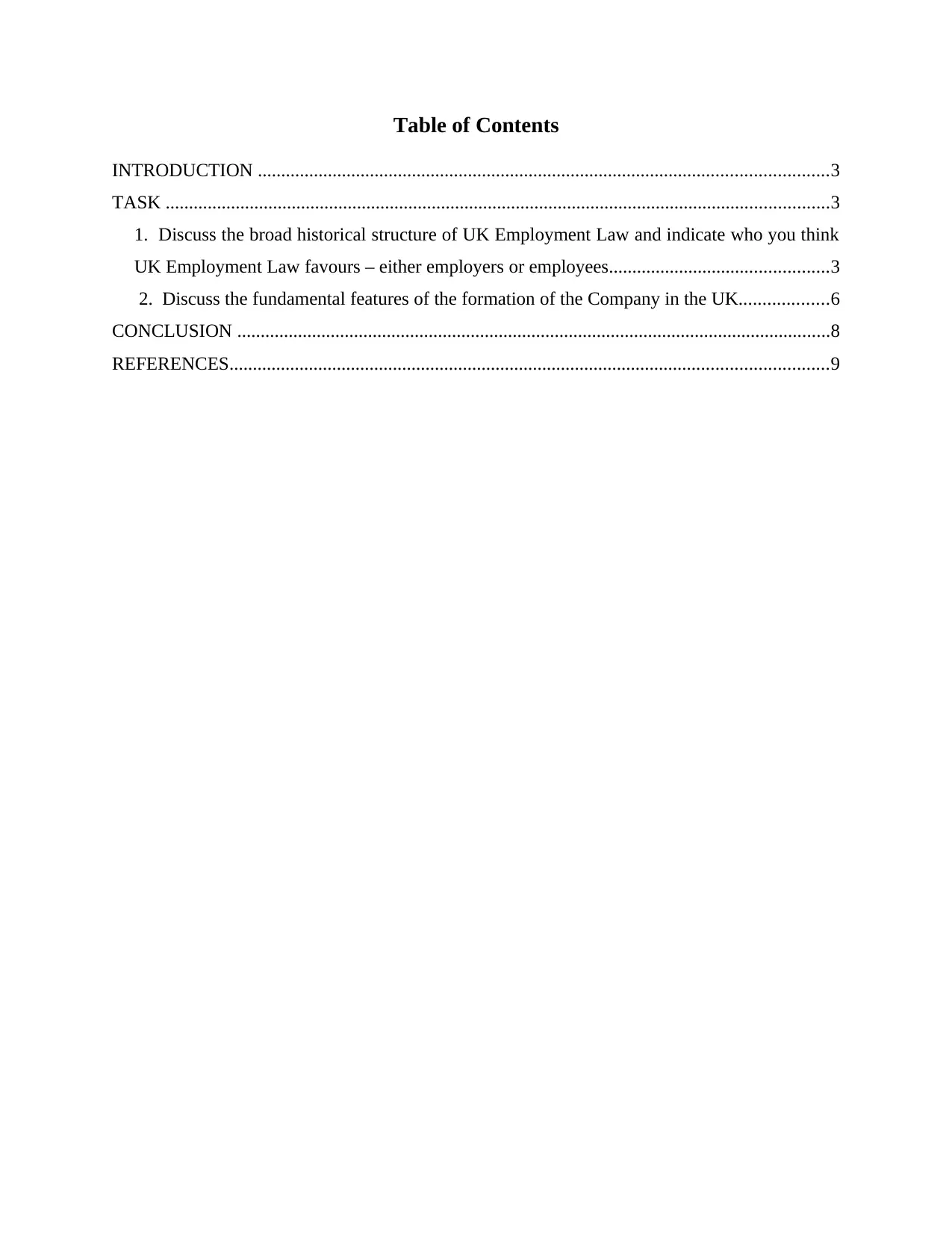
Table of Contents
INTRODUCTION ..........................................................................................................................3
TASK ..............................................................................................................................................3
1. Discuss the broad historical structure of UK Employment Law and indicate who you think
UK Employment Law favours – either employers or employees...............................................3
2. Discuss the fundamental features of the formation of the Company in the UK...................6
CONCLUSION ...............................................................................................................................8
REFERENCES................................................................................................................................9
INTRODUCTION ..........................................................................................................................3
TASK ..............................................................................................................................................3
1. Discuss the broad historical structure of UK Employment Law and indicate who you think
UK Employment Law favours – either employers or employees...............................................3
2. Discuss the fundamental features of the formation of the Company in the UK...................6
CONCLUSION ...............................................................................................................................8
REFERENCES................................................................................................................................9
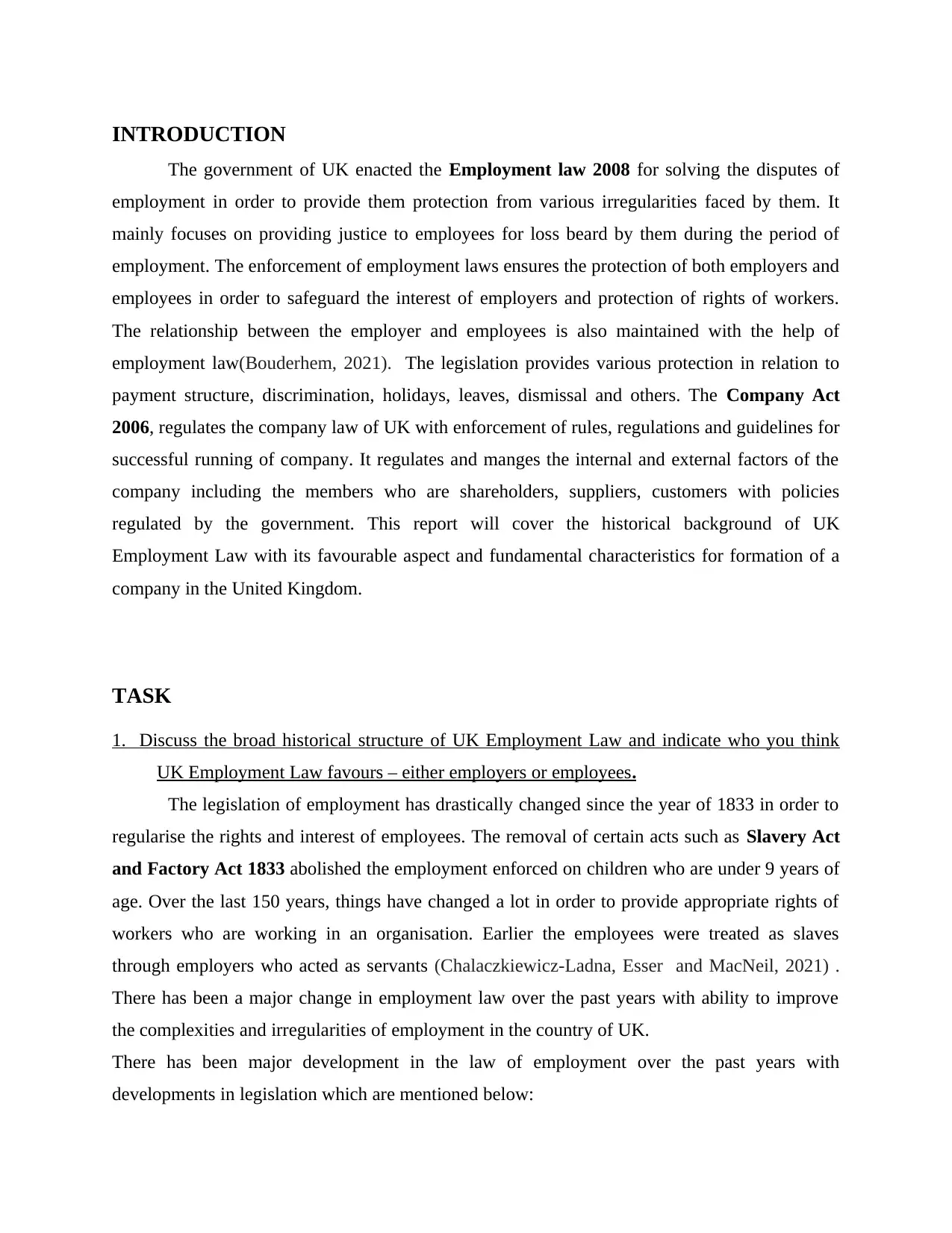
INTRODUCTION
The government of UK enacted the Employment law 2008 for solving the disputes of
employment in order to provide them protection from various irregularities faced by them. It
mainly focuses on providing justice to employees for loss beard by them during the period of
employment. The enforcement of employment laws ensures the protection of both employers and
employees in order to safeguard the interest of employers and protection of rights of workers.
The relationship between the employer and employees is also maintained with the help of
employment law(Bouderhem, 2021). The legislation provides various protection in relation to
payment structure, discrimination, holidays, leaves, dismissal and others. The Company Act
2006, regulates the company law of UK with enforcement of rules, regulations and guidelines for
successful running of company. It regulates and manges the internal and external factors of the
company including the members who are shareholders, suppliers, customers with policies
regulated by the government. This report will cover the historical background of UK
Employment Law with its favourable aspect and fundamental characteristics for formation of a
company in the United Kingdom.
TASK
1. Discuss the broad historical structure of UK Employment Law and indicate who you think
UK Employment Law favours – either employers or employees.
The legislation of employment has drastically changed since the year of 1833 in order to
regularise the rights and interest of employees. The removal of certain acts such as Slavery Act
and Factory Act 1833 abolished the employment enforced on children who are under 9 years of
age. Over the last 150 years, things have changed a lot in order to provide appropriate rights of
workers who are working in an organisation. Earlier the employees were treated as slaves
through employers who acted as servants (Chalaczkiewicz-Ladna, Esser and MacNeil, 2021) .
There has been a major change in employment law over the past years with ability to improve
the complexities and irregularities of employment in the country of UK.
There has been major development in the law of employment over the past years with
developments in legislation which are mentioned below:
The government of UK enacted the Employment law 2008 for solving the disputes of
employment in order to provide them protection from various irregularities faced by them. It
mainly focuses on providing justice to employees for loss beard by them during the period of
employment. The enforcement of employment laws ensures the protection of both employers and
employees in order to safeguard the interest of employers and protection of rights of workers.
The relationship between the employer and employees is also maintained with the help of
employment law(Bouderhem, 2021). The legislation provides various protection in relation to
payment structure, discrimination, holidays, leaves, dismissal and others. The Company Act
2006, regulates the company law of UK with enforcement of rules, regulations and guidelines for
successful running of company. It regulates and manges the internal and external factors of the
company including the members who are shareholders, suppliers, customers with policies
regulated by the government. This report will cover the historical background of UK
Employment Law with its favourable aspect and fundamental characteristics for formation of a
company in the United Kingdom.
TASK
1. Discuss the broad historical structure of UK Employment Law and indicate who you think
UK Employment Law favours – either employers or employees.
The legislation of employment has drastically changed since the year of 1833 in order to
regularise the rights and interest of employees. The removal of certain acts such as Slavery Act
and Factory Act 1833 abolished the employment enforced on children who are under 9 years of
age. Over the last 150 years, things have changed a lot in order to provide appropriate rights of
workers who are working in an organisation. Earlier the employees were treated as slaves
through employers who acted as servants (Chalaczkiewicz-Ladna, Esser and MacNeil, 2021) .
There has been a major change in employment law over the past years with ability to improve
the complexities and irregularities of employment in the country of UK.
There has been major development in the law of employment over the past years with
developments in legislation which are mentioned below:
⊘ This is a preview!⊘
Do you want full access?
Subscribe today to unlock all pages.

Trusted by 1+ million students worldwide
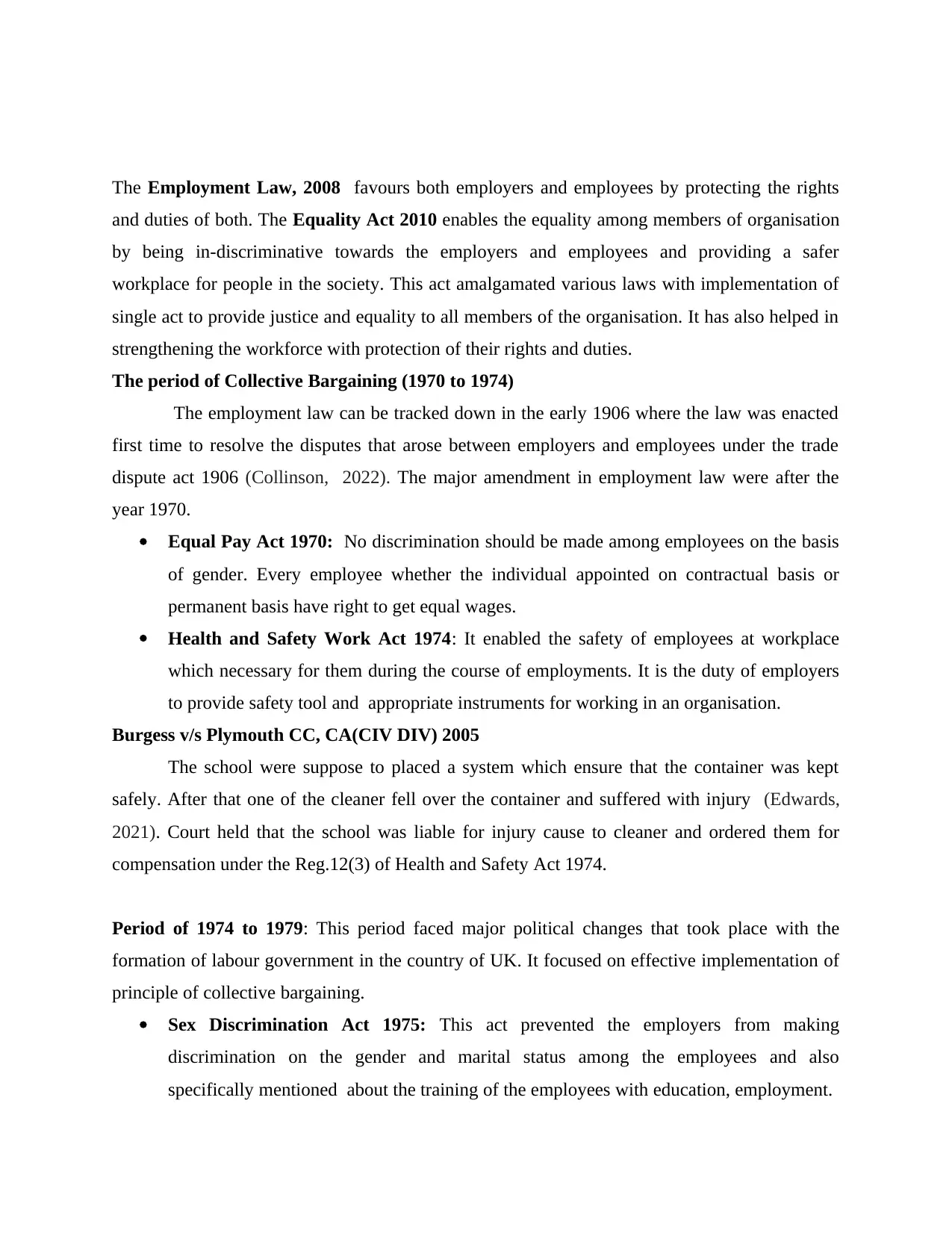
The Employment Law, 2008 favours both employers and employees by protecting the rights
and duties of both. The Equality Act 2010 enables the equality among members of organisation
by being in-discriminative towards the employers and employees and providing a safer
workplace for people in the society. This act amalgamated various laws with implementation of
single act to provide justice and equality to all members of the organisation. It has also helped in
strengthening the workforce with protection of their rights and duties.
The period of Collective Bargaining (1970 to 1974)
The employment law can be tracked down in the early 1906 where the law was enacted
first time to resolve the disputes that arose between employers and employees under the trade
dispute act 1906 (Collinson, 2022). The major amendment in employment law were after the
year 1970.
Equal Pay Act 1970: No discrimination should be made among employees on the basis
of gender. Every employee whether the individual appointed on contractual basis or
permanent basis have right to get equal wages.
Health and Safety Work Act 1974: It enabled the safety of employees at workplace
which necessary for them during the course of employments. It is the duty of employers
to provide safety tool and appropriate instruments for working in an organisation.
Burgess v/s Plymouth CC, CA(CIV DIV) 2005
The school were suppose to placed a system which ensure that the container was kept
safely. After that one of the cleaner fell over the container and suffered with injury (Edwards,
2021). Court held that the school was liable for injury cause to cleaner and ordered them for
compensation under the Reg.12(3) of Health and Safety Act 1974.
Period of 1974 to 1979: This period faced major political changes that took place with the
formation of labour government in the country of UK. It focused on effective implementation of
principle of collective bargaining.
Sex Discrimination Act 1975: This act prevented the employers from making
discrimination on the gender and marital status among the employees and also
specifically mentioned about the training of the employees with education, employment.
and duties of both. The Equality Act 2010 enables the equality among members of organisation
by being in-discriminative towards the employers and employees and providing a safer
workplace for people in the society. This act amalgamated various laws with implementation of
single act to provide justice and equality to all members of the organisation. It has also helped in
strengthening the workforce with protection of their rights and duties.
The period of Collective Bargaining (1970 to 1974)
The employment law can be tracked down in the early 1906 where the law was enacted
first time to resolve the disputes that arose between employers and employees under the trade
dispute act 1906 (Collinson, 2022). The major amendment in employment law were after the
year 1970.
Equal Pay Act 1970: No discrimination should be made among employees on the basis
of gender. Every employee whether the individual appointed on contractual basis or
permanent basis have right to get equal wages.
Health and Safety Work Act 1974: It enabled the safety of employees at workplace
which necessary for them during the course of employments. It is the duty of employers
to provide safety tool and appropriate instruments for working in an organisation.
Burgess v/s Plymouth CC, CA(CIV DIV) 2005
The school were suppose to placed a system which ensure that the container was kept
safely. After that one of the cleaner fell over the container and suffered with injury (Edwards,
2021). Court held that the school was liable for injury cause to cleaner and ordered them for
compensation under the Reg.12(3) of Health and Safety Act 1974.
Period of 1974 to 1979: This period faced major political changes that took place with the
formation of labour government in the country of UK. It focused on effective implementation of
principle of collective bargaining.
Sex Discrimination Act 1975: This act prevented the employers from making
discrimination on the gender and marital status among the employees and also
specifically mentioned about the training of the employees with education, employment.
Paraphrase This Document
Need a fresh take? Get an instant paraphrase of this document with our AI Paraphraser
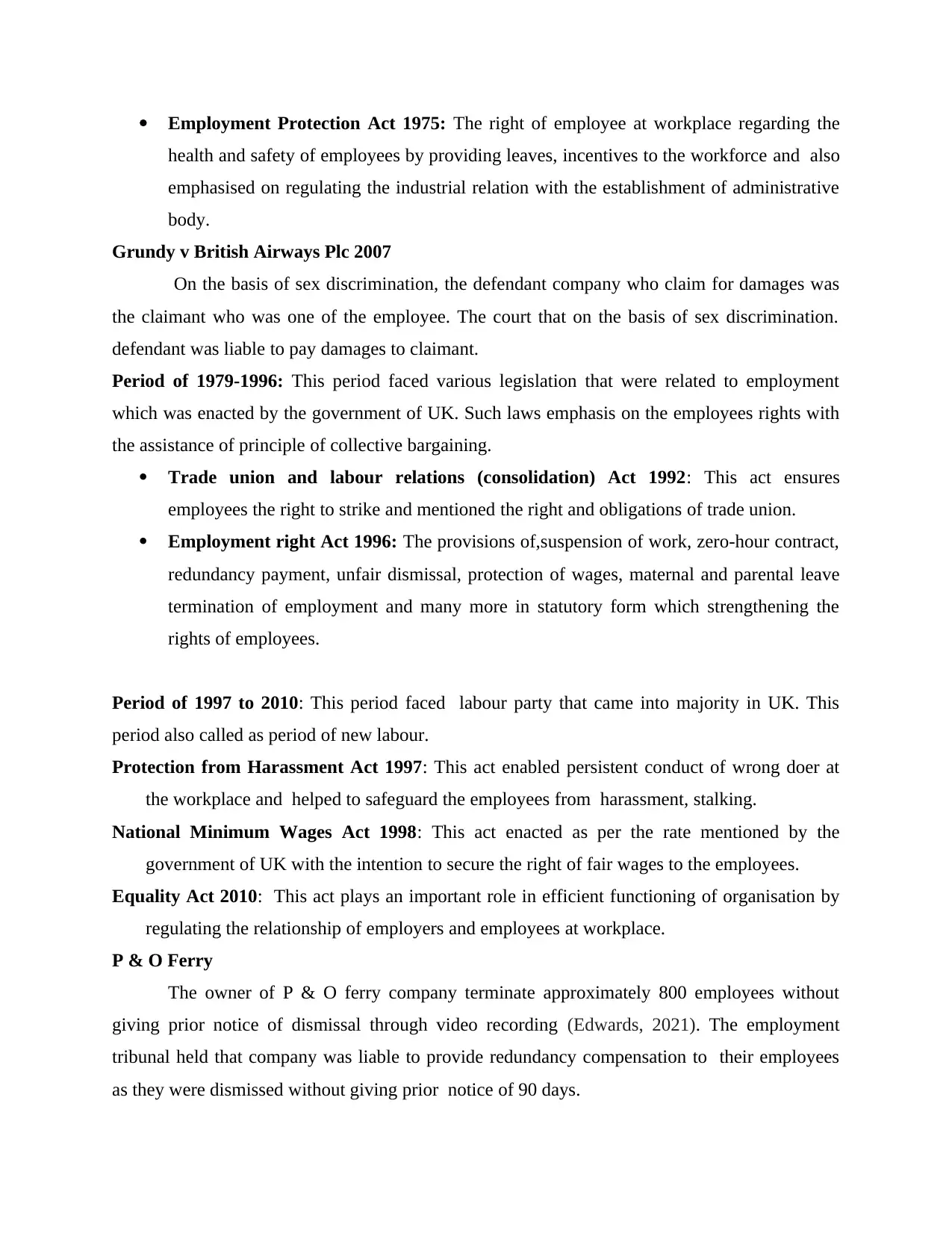
Employment Protection Act 1975: The right of employee at workplace regarding the
health and safety of employees by providing leaves, incentives to the workforce and also
emphasised on regulating the industrial relation with the establishment of administrative
body.
Grundy v British Airways Plc 2007
On the basis of sex discrimination, the defendant company who claim for damages was
the claimant who was one of the employee. The court that on the basis of sex discrimination.
defendant was liable to pay damages to claimant.
Period of 1979-1996: This period faced various legislation that were related to employment
which was enacted by the government of UK. Such laws emphasis on the employees rights with
the assistance of principle of collective bargaining.
Trade union and labour relations (consolidation) Act 1992: This act ensures
employees the right to strike and mentioned the right and obligations of trade union.
Employment right Act 1996: The provisions of,suspension of work, zero-hour contract,
redundancy payment, unfair dismissal, protection of wages, maternal and parental leave
termination of employment and many more in statutory form which strengthening the
rights of employees.
Period of 1997 to 2010: This period faced labour party that came into majority in UK. This
period also called as period of new labour.
Protection from Harassment Act 1997: This act enabled persistent conduct of wrong doer at
the workplace and helped to safeguard the employees from harassment, stalking.
National Minimum Wages Act 1998: This act enacted as per the rate mentioned by the
government of UK with the intention to secure the right of fair wages to the employees.
Equality Act 2010: This act plays an important role in efficient functioning of organisation by
regulating the relationship of employers and employees at workplace.
P & O Ferry
The owner of P & O ferry company terminate approximately 800 employees without
giving prior notice of dismissal through video recording (Edwards, 2021). The employment
tribunal held that company was liable to provide redundancy compensation to their employees
as they were dismissed without giving prior notice of 90 days.
health and safety of employees by providing leaves, incentives to the workforce and also
emphasised on regulating the industrial relation with the establishment of administrative
body.
Grundy v British Airways Plc 2007
On the basis of sex discrimination, the defendant company who claim for damages was
the claimant who was one of the employee. The court that on the basis of sex discrimination.
defendant was liable to pay damages to claimant.
Period of 1979-1996: This period faced various legislation that were related to employment
which was enacted by the government of UK. Such laws emphasis on the employees rights with
the assistance of principle of collective bargaining.
Trade union and labour relations (consolidation) Act 1992: This act ensures
employees the right to strike and mentioned the right and obligations of trade union.
Employment right Act 1996: The provisions of,suspension of work, zero-hour contract,
redundancy payment, unfair dismissal, protection of wages, maternal and parental leave
termination of employment and many more in statutory form which strengthening the
rights of employees.
Period of 1997 to 2010: This period faced labour party that came into majority in UK. This
period also called as period of new labour.
Protection from Harassment Act 1997: This act enabled persistent conduct of wrong doer at
the workplace and helped to safeguard the employees from harassment, stalking.
National Minimum Wages Act 1998: This act enacted as per the rate mentioned by the
government of UK with the intention to secure the right of fair wages to the employees.
Equality Act 2010: This act plays an important role in efficient functioning of organisation by
regulating the relationship of employers and employees at workplace.
P & O Ferry
The owner of P & O ferry company terminate approximately 800 employees without
giving prior notice of dismissal through video recording (Edwards, 2021). The employment
tribunal held that company was liable to provide redundancy compensation to their employees
as they were dismissed without giving prior notice of 90 days.
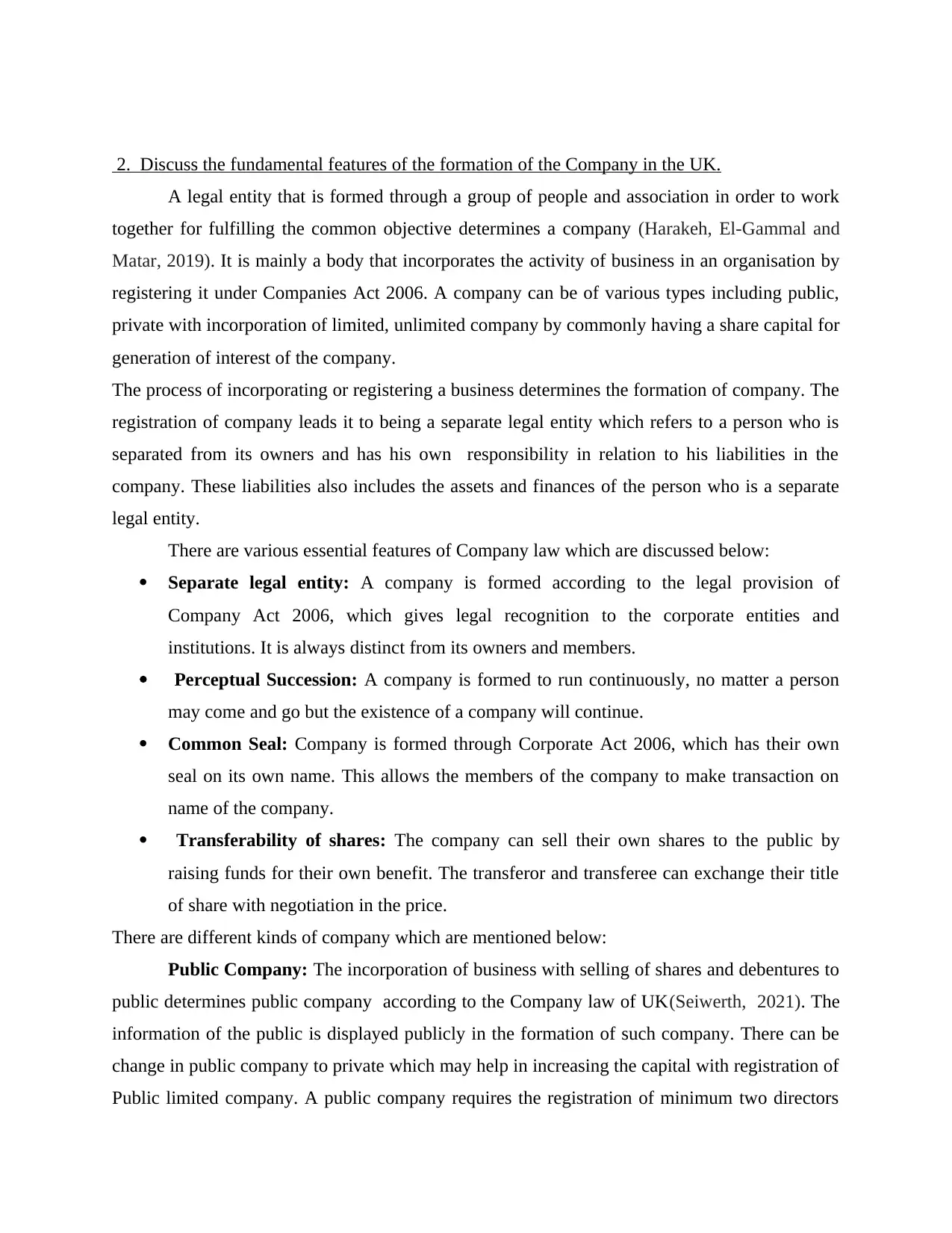
2. Discuss the fundamental features of the formation of the Company in the UK.
A legal entity that is formed through a group of people and association in order to work
together for fulfilling the common objective determines a company (Harakeh, El-Gammal and
Matar, 2019). It is mainly a body that incorporates the activity of business in an organisation by
registering it under Companies Act 2006. A company can be of various types including public,
private with incorporation of limited, unlimited company by commonly having a share capital for
generation of interest of the company.
The process of incorporating or registering a business determines the formation of company. The
registration of company leads it to being a separate legal entity which refers to a person who is
separated from its owners and has his own responsibility in relation to his liabilities in the
company. These liabilities also includes the assets and finances of the person who is a separate
legal entity.
There are various essential features of Company law which are discussed below:
Separate legal entity: A company is formed according to the legal provision of
Company Act 2006, which gives legal recognition to the corporate entities and
institutions. It is always distinct from its owners and members.
Perceptual Succession: A company is formed to run continuously, no matter a person
may come and go but the existence of a company will continue.
Common Seal: Company is formed through Corporate Act 2006, which has their own
seal on its own name. This allows the members of the company to make transaction on
name of the company.
Transferability of shares: The company can sell their own shares to the public by
raising funds for their own benefit. The transferor and transferee can exchange their title
of share with negotiation in the price.
There are different kinds of company which are mentioned below:
Public Company: The incorporation of business with selling of shares and debentures to
public determines public company according to the Company law of UK(Seiwerth, 2021). The
information of the public is displayed publicly in the formation of such company. There can be
change in public company to private which may help in increasing the capital with registration of
Public limited company. A public company requires the registration of minimum two directors
A legal entity that is formed through a group of people and association in order to work
together for fulfilling the common objective determines a company (Harakeh, El-Gammal and
Matar, 2019). It is mainly a body that incorporates the activity of business in an organisation by
registering it under Companies Act 2006. A company can be of various types including public,
private with incorporation of limited, unlimited company by commonly having a share capital for
generation of interest of the company.
The process of incorporating or registering a business determines the formation of company. The
registration of company leads it to being a separate legal entity which refers to a person who is
separated from its owners and has his own responsibility in relation to his liabilities in the
company. These liabilities also includes the assets and finances of the person who is a separate
legal entity.
There are various essential features of Company law which are discussed below:
Separate legal entity: A company is formed according to the legal provision of
Company Act 2006, which gives legal recognition to the corporate entities and
institutions. It is always distinct from its owners and members.
Perceptual Succession: A company is formed to run continuously, no matter a person
may come and go but the existence of a company will continue.
Common Seal: Company is formed through Corporate Act 2006, which has their own
seal on its own name. This allows the members of the company to make transaction on
name of the company.
Transferability of shares: The company can sell their own shares to the public by
raising funds for their own benefit. The transferor and transferee can exchange their title
of share with negotiation in the price.
There are different kinds of company which are mentioned below:
Public Company: The incorporation of business with selling of shares and debentures to
public determines public company according to the Company law of UK(Seiwerth, 2021). The
information of the public is displayed publicly in the formation of such company. There can be
change in public company to private which may help in increasing the capital with registration of
Public limited company. A public company requires the registration of minimum two directors
⊘ This is a preview!⊘
Do you want full access?
Subscribe today to unlock all pages.

Trusted by 1+ million students worldwide
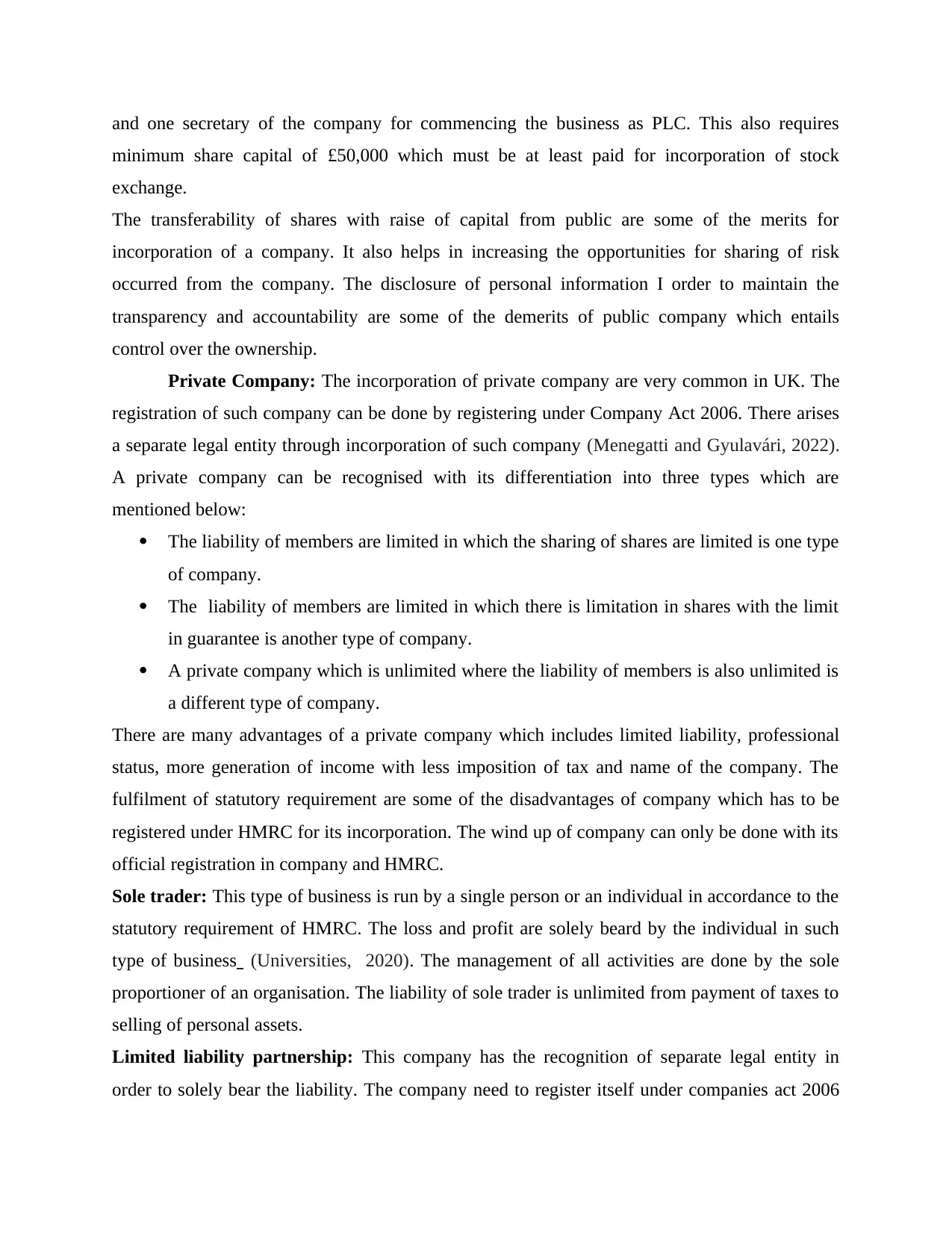
and one secretary of the company for commencing the business as PLC. This also requires
minimum share capital of £50,000 which must be at least paid for incorporation of stock
exchange.
The transferability of shares with raise of capital from public are some of the merits for
incorporation of a company. It also helps in increasing the opportunities for sharing of risk
occurred from the company. The disclosure of personal information I order to maintain the
transparency and accountability are some of the demerits of public company which entails
control over the ownership.
Private Company: The incorporation of private company are very common in UK. The
registration of such company can be done by registering under Company Act 2006. There arises
a separate legal entity through incorporation of such company (Menegatti and Gyulavári, 2022).
A private company can be recognised with its differentiation into three types which are
mentioned below:
The liability of members are limited in which the sharing of shares are limited is one type
of company.
The liability of members are limited in which there is limitation in shares with the limit
in guarantee is another type of company.
A private company which is unlimited where the liability of members is also unlimited is
a different type of company.
There are many advantages of a private company which includes limited liability, professional
status, more generation of income with less imposition of tax and name of the company. The
fulfilment of statutory requirement are some of the disadvantages of company which has to be
registered under HMRC for its incorporation. The wind up of company can only be done with its
official registration in company and HMRC.
Sole trader: This type of business is run by a single person or an individual in accordance to the
statutory requirement of HMRC. The loss and profit are solely beard by the individual in such
type of business (Universities, 2020). The management of all activities are done by the sole
proportioner of an organisation. The liability of sole trader is unlimited from payment of taxes to
selling of personal assets.
Limited liability partnership: This company has the recognition of separate legal entity in
order to solely bear the liability. The company need to register itself under companies act 2006
minimum share capital of £50,000 which must be at least paid for incorporation of stock
exchange.
The transferability of shares with raise of capital from public are some of the merits for
incorporation of a company. It also helps in increasing the opportunities for sharing of risk
occurred from the company. The disclosure of personal information I order to maintain the
transparency and accountability are some of the demerits of public company which entails
control over the ownership.
Private Company: The incorporation of private company are very common in UK. The
registration of such company can be done by registering under Company Act 2006. There arises
a separate legal entity through incorporation of such company (Menegatti and Gyulavári, 2022).
A private company can be recognised with its differentiation into three types which are
mentioned below:
The liability of members are limited in which the sharing of shares are limited is one type
of company.
The liability of members are limited in which there is limitation in shares with the limit
in guarantee is another type of company.
A private company which is unlimited where the liability of members is also unlimited is
a different type of company.
There are many advantages of a private company which includes limited liability, professional
status, more generation of income with less imposition of tax and name of the company. The
fulfilment of statutory requirement are some of the disadvantages of company which has to be
registered under HMRC for its incorporation. The wind up of company can only be done with its
official registration in company and HMRC.
Sole trader: This type of business is run by a single person or an individual in accordance to the
statutory requirement of HMRC. The loss and profit are solely beard by the individual in such
type of business (Universities, 2020). The management of all activities are done by the sole
proportioner of an organisation. The liability of sole trader is unlimited from payment of taxes to
selling of personal assets.
Limited liability partnership: This company has the recognition of separate legal entity in
order to solely bear the liability. The company need to register itself under companies act 2006
Paraphrase This Document
Need a fresh take? Get an instant paraphrase of this document with our AI Paraphraser
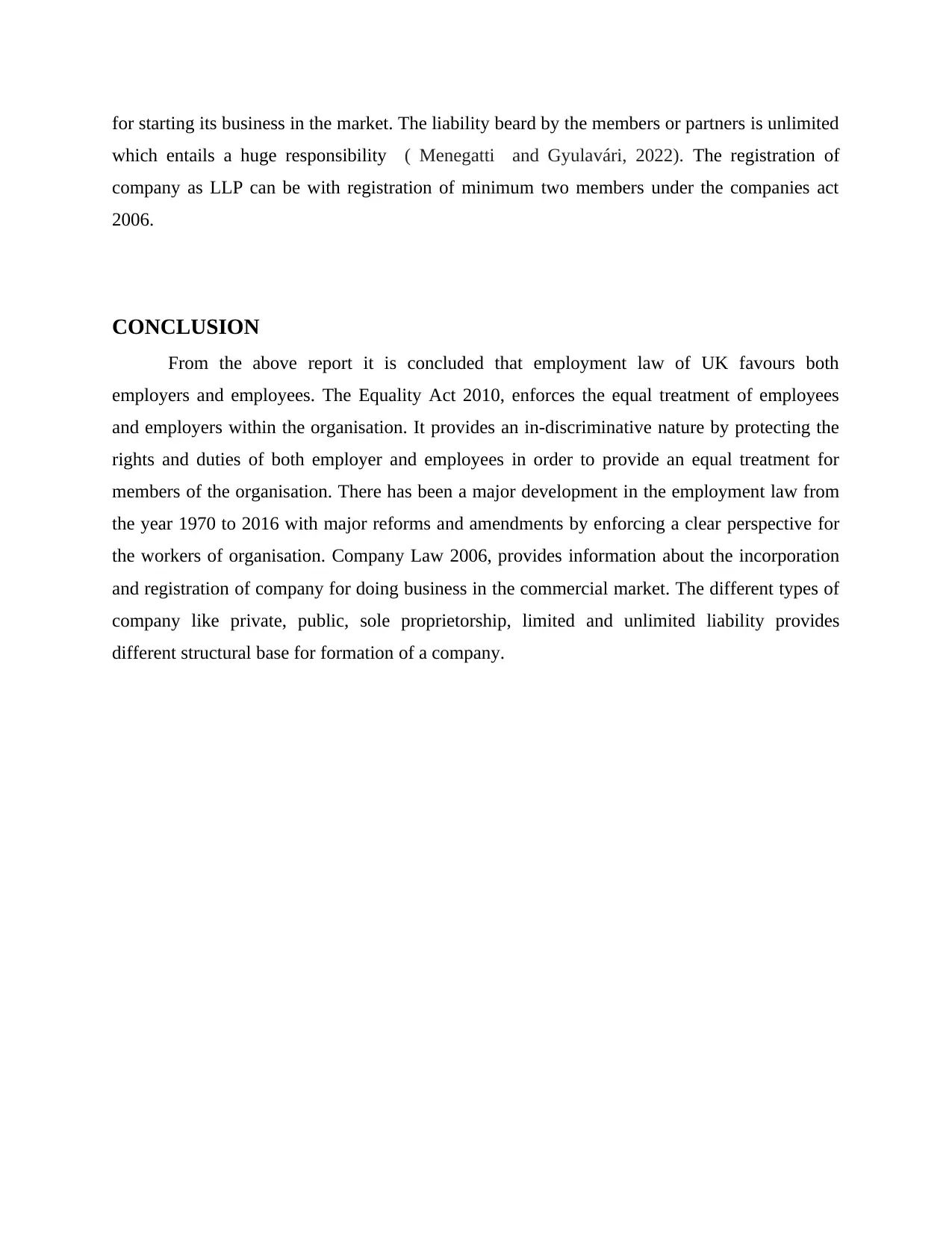
for starting its business in the market. The liability beard by the members or partners is unlimited
which entails a huge responsibility ( Menegatti and Gyulavári, 2022). The registration of
company as LLP can be with registration of minimum two members under the companies act
2006.
CONCLUSION
From the above report it is concluded that employment law of UK favours both
employers and employees. The Equality Act 2010, enforces the equal treatment of employees
and employers within the organisation. It provides an in-discriminative nature by protecting the
rights and duties of both employer and employees in order to provide an equal treatment for
members of the organisation. There has been a major development in the employment law from
the year 1970 to 2016 with major reforms and amendments by enforcing a clear perspective for
the workers of organisation. Company Law 2006, provides information about the incorporation
and registration of company for doing business in the commercial market. The different types of
company like private, public, sole proprietorship, limited and unlimited liability provides
different structural base for formation of a company.
which entails a huge responsibility ( Menegatti and Gyulavári, 2022). The registration of
company as LLP can be with registration of minimum two members under the companies act
2006.
CONCLUSION
From the above report it is concluded that employment law of UK favours both
employers and employees. The Equality Act 2010, enforces the equal treatment of employees
and employers within the organisation. It provides an in-discriminative nature by protecting the
rights and duties of both employer and employees in order to provide an equal treatment for
members of the organisation. There has been a major development in the employment law from
the year 1970 to 2016 with major reforms and amendments by enforcing a clear perspective for
the workers of organisation. Company Law 2006, provides information about the incorporation
and registration of company for doing business in the commercial market. The different types of
company like private, public, sole proprietorship, limited and unlimited liability provides
different structural base for formation of a company.
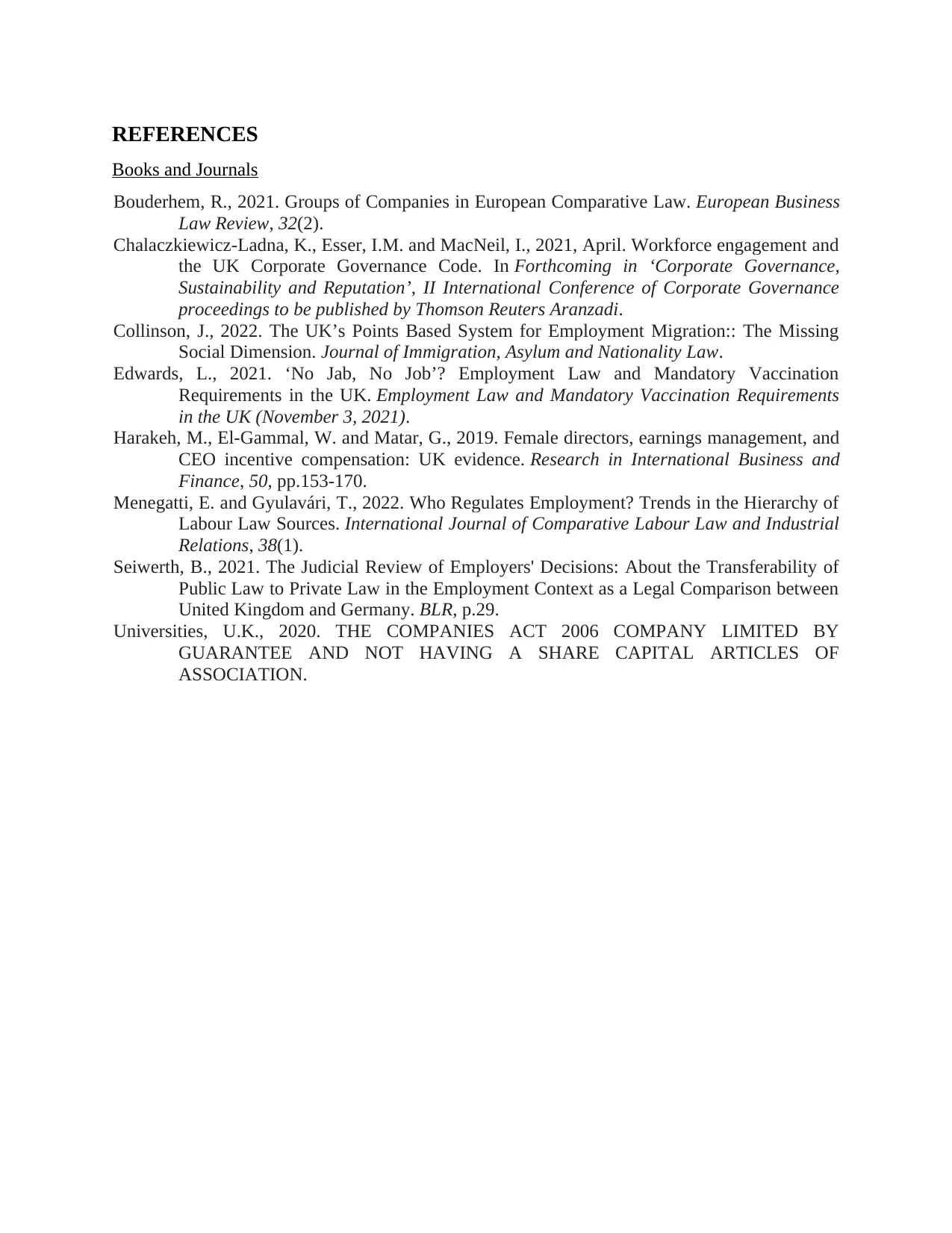
REFERENCES
Books and Journals
Bouderhem, R., 2021. Groups of Companies in European Comparative Law. European Business
Law Review, 32(2).
Chalaczkiewicz-Ladna, K., Esser, I.M. and MacNeil, I., 2021, April. Workforce engagement and
the UK Corporate Governance Code. In Forthcoming in ‘Corporate Governance,
Sustainability and Reputation’, II International Conference of Corporate Governance
proceedings to be published by Thomson Reuters Aranzadi.
Collinson, J., 2022. The UK’s Points Based System for Employment Migration:: The Missing
Social Dimension. Journal of Immigration, Asylum and Nationality Law.
Edwards, L., 2021. ‘No Jab, No Job’? Employment Law and Mandatory Vaccination
Requirements in the UK. Employment Law and Mandatory Vaccination Requirements
in the UK (November 3, 2021).
Harakeh, M., El-Gammal, W. and Matar, G., 2019. Female directors, earnings management, and
CEO incentive compensation: UK evidence. Research in International Business and
Finance, 50, pp.153-170.
Menegatti, E. and Gyulavári, T., 2022. Who Regulates Employment? Trends in the Hierarchy of
Labour Law Sources. International Journal of Comparative Labour Law and Industrial
Relations, 38(1).
Seiwerth, B., 2021. The Judicial Review of Employers' Decisions: About the Transferability of
Public Law to Private Law in the Employment Context as a Legal Comparison between
United Kingdom and Germany. BLR, p.29.
Universities, U.K., 2020. THE COMPANIES ACT 2006 COMPANY LIMITED BY
GUARANTEE AND NOT HAVING A SHARE CAPITAL ARTICLES OF
ASSOCIATION.
Books and Journals
Bouderhem, R., 2021. Groups of Companies in European Comparative Law. European Business
Law Review, 32(2).
Chalaczkiewicz-Ladna, K., Esser, I.M. and MacNeil, I., 2021, April. Workforce engagement and
the UK Corporate Governance Code. In Forthcoming in ‘Corporate Governance,
Sustainability and Reputation’, II International Conference of Corporate Governance
proceedings to be published by Thomson Reuters Aranzadi.
Collinson, J., 2022. The UK’s Points Based System for Employment Migration:: The Missing
Social Dimension. Journal of Immigration, Asylum and Nationality Law.
Edwards, L., 2021. ‘No Jab, No Job’? Employment Law and Mandatory Vaccination
Requirements in the UK. Employment Law and Mandatory Vaccination Requirements
in the UK (November 3, 2021).
Harakeh, M., El-Gammal, W. and Matar, G., 2019. Female directors, earnings management, and
CEO incentive compensation: UK evidence. Research in International Business and
Finance, 50, pp.153-170.
Menegatti, E. and Gyulavári, T., 2022. Who Regulates Employment? Trends in the Hierarchy of
Labour Law Sources. International Journal of Comparative Labour Law and Industrial
Relations, 38(1).
Seiwerth, B., 2021. The Judicial Review of Employers' Decisions: About the Transferability of
Public Law to Private Law in the Employment Context as a Legal Comparison between
United Kingdom and Germany. BLR, p.29.
Universities, U.K., 2020. THE COMPANIES ACT 2006 COMPANY LIMITED BY
GUARANTEE AND NOT HAVING A SHARE CAPITAL ARTICLES OF
ASSOCIATION.
⊘ This is a preview!⊘
Do you want full access?
Subscribe today to unlock all pages.

Trusted by 1+ million students worldwide
1 out of 9
Related Documents
Your All-in-One AI-Powered Toolkit for Academic Success.
+13062052269
info@desklib.com
Available 24*7 on WhatsApp / Email
![[object Object]](/_next/static/media/star-bottom.7253800d.svg)
Unlock your academic potential
Copyright © 2020–2025 A2Z Services. All Rights Reserved. Developed and managed by ZUCOL.




